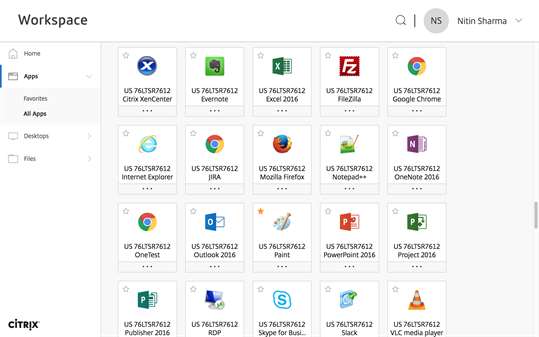Citrix does not recommend extracting the Receiver (Enterprise) .msi files instead of running the installer packages. However, there might be times when you have to extract the .msi files from CitrixReceiver.exe or CitrixReceiverEnterprise.exe manually, rather than running the installer package (for example, company policy prohibits the usage of .exe files). If you use the extracted .msi files for your installation, using the .exe installer package to upgrade or uninstall and reinstall might not work properly.
For Citrix-recommended Receiver (Enterprise) installation methods, refer to Citrix eDocs - Configure and install Receiver for Windows using command-line parameters.
Extract the .msi files
Citrix Workspace app is the new universal app for all workspace services, that will encompass all Citrix clients and app capabilities over time. This article describes how to manually extract, install, and remove individual.msi files from CitrixReceiver.exe OR ReceiverEnterprise.exe. You can download Ci. This ZIP file contains sample scripts to deploy and configure Citrix Workspace app. It is an optional download, provided on an as-is basis by Citrix to serve as an example. Before use, IT administrators must customize the scripts to suit their environment. The uninstall and install scripts may be used as noted in the upgrade guide for Citrix. Download Citrix Workspace App, Citrix ADC and all other Citrix workspace and networking products. Receive version updates, utilities and detailed tech information. Download Citrix Workspace app Everything you need—your apps, files and desktops—at your fingertips. Citrix Workspace app is the easy-to-install client software that provides seamless, secure access to everything you need to get work done. With this free download, you easily and securely get instant access to all applications, desktops.
Run the following at command prompt:
For 4.x use: CitrixReceiver.exe /extract [Destination_name, e.g. C:test ]
For 3.x use: CitrixReceiverEnterprise.exe /extract [Destination_name, e.g. C:test]
where Destination _name is a complete pathname to the directory into which the .msi files are extracted. The directory must exist already and /extract adds a subfolder called extract to that directory.
For example, if you create a C:test directory and run /extract, the extracted .msi files are put in C:testextract.
Note: If User Access Control (UAC) is enabled, Citrix advises that you install the .msi files in elevated mode. The .msi files are supported per-machine and require administrator privileges to deploy them.
Install the .msi files for Receiver
Use the following command line parameter:
Note: Double click installation for Receiver using individual .msi is not recommended for 4.4.x and 4.5Install the Components:
When installing the Receiver.exe components, run the .msi files in the following order:
- RIInstaller.msi
- ICAWebWrapper.msi
- GenericUSB.msi
- DesktopViewer.msi
- CitrixHDXMediaStreamForFlash-ClientInstall.msi
- Vd3dClient.msi
- AuthManager.msi
- SSONWrapper.msi
- SelfServicePlugin.msi
- WebHelper.msi
During the execution of each of these msi packages, the following command line parameters need to specified:
REBOOT=ReallySuppress MSIDISABLERMRESTART=0 MSIRESTARTMANAGERCONTROL=0 NEED_RECEIVER=n TROLLEYINSTALL=1 ALLUSERS=1
The command to execute a msi package is as follows:
msiexec /i <path to the .msi package> REBOOT=ReallySuppress MSIDISABLERMRESTART=0 MSIRESTARTMANAGERCONTROL=0 NEED_RECEIVER=n TROLLEYINSTALL=1 ALLUSERS=1
For a non-admin user installation, the parameters are as follows:
REBOOT=ReallySuppress MSIDISABLERMRESTART=0 MSIRESTARTMANAGERCONTROL=0 NEED_RECEIVER=n TROLLEYINSTALL=1 ALLUSERS='
Note: GenericUSB and SSON are not supported for non-admin users, so no need to install GenericUSB.msi and SSONWrapper.msi for non-admin user installation.
Remove the Components:
When removing the components, remove them in the following order:
- SelfServicePlugin.msi
- SSONWrapper.msi
- AuthManager.msi
- Vd3dClient.msi
- CitrixHDXMediaStreamForFlash-ClientInstall.msi
- DesktopViewer.msi
- GenericUSB.msi
- ICAWebWrapper.msi
- RIInstaller.msi
- WebHelper.msi
Each .msi file has an Add/Remove (Control Panel on Windows XP or Windows Server 2003) or Programs and Features (Control Panel on Windows Vista, Windows 7, and Windows Server 2008) entry in the following format:
| Name of package | Name displayed in Add/Remove or Programs and Features |
| RIInstaller.msi | Citrix Receiver Inside |
| ICAWebWrapper.msi | Online Plug-in |
| PNAWrapper.msi | Citrix Receiver (PNA) |
| SSONWrapper.msi | Citrix Receiver (SSON) |
| CitrixHDXMediaStreamForFlash-ClientInstall.msi | Citrix Receiver (HDX Flash Redirection) |
| DesktopViewer.msi | Citrix Receiver (DV) |
| GenericUSB.msi | Citrix Receiver (USB) |
| Vd3d.msi | Citrix Receiver (Aero) |
| AuthManager.msi | Citrix Authentication Manager |
| CitrixReceiverUpdater-User.msi | Citrix Receiver Updater |
| SelfServicePlugin.msi | Citrix Single Sign-On Plug-in |


Citrix Workspace Download Msi Installer
Note: CitrixReceiverUpdater-user.msi is not included in Citrix Receiver from version 4.3 onwards
